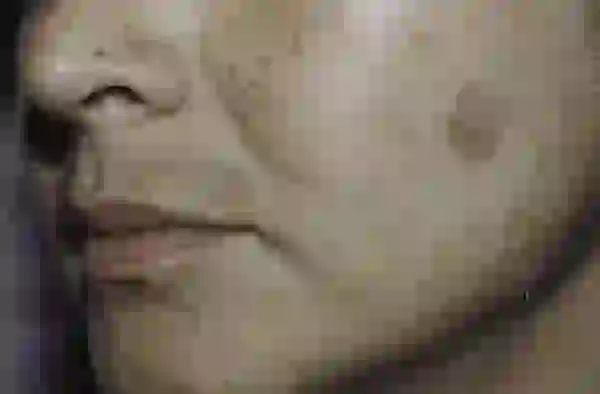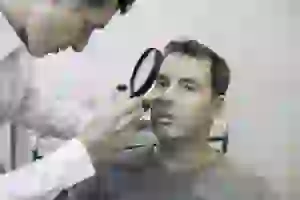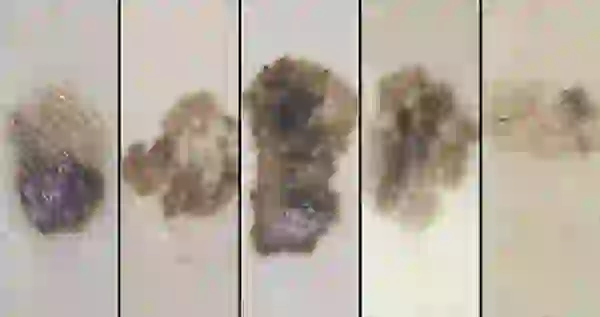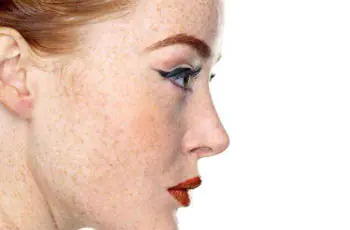Not only the physical health, but also the psychological state of a person depends on the condition of the skin and its appearance. Pigment spots, especially on open areas of the body, can cause a lot of inconvenience to a person, no matter what age he is. But you shouldn’t consider a pigmentation disorder as just an annoying aesthetic problem - in some cases, a pigment spot may be a signal that it’s time to go to the hospital and undergo a full examination. In order to preserve youth and health of the skin for a long time, you need to know why the production of pigments is disrupted and how to permanently get rid of age spots on the face.
What is a pigment spot?



In a healthy person, special cells - melanocytes - constantly synthesize the pigment - melanin. This substance determines the color of hair, skin and eyes. Also, normally, the production of melanin is enhanced by ultraviolet radiation - a bronze tan appears on the skin. But sometimes, under the influence of environmental factors, as well as pathological processes that occur inside the body, the normal production of melanin is disrupted, which leads to the appearance of age spots on the face.
A pigment spot is a limited area of skin in which hyperpigmentation or hypopigmentation is observed. Hyperpigmentation is caused by excessive synthesis of melanin, hypopigmentation is caused by a decrease in the intensity of this process. Pigmentation disorders can manifest themselves in various diseases of internal organs, and can also be a consequence of already suffered dermatological diseases.
Why do age spots appear on the face?
The face is that part of the body that is constantly under the influence of negative factors. This is why pigmentation disorders most often develop on the face. Experts identify a number of reasons why age spots develop on the face. These include:
- exposure to ultraviolet rays. As already mentioned, under the influence of ultraviolet radiation, the skin becomes darker, as melanin synthesis increases. However, with prolonged exposure to direct sunlight, as well as with frequent visits to the solarium, pigment spots appear on the skin - this is a protective reaction of the body.
- genetic predisposition to hyperpigmentation. Heredity also plays a very important role. Doctors note that in children whose parents suffer from age spots, the risk of their occurrence increases several times.
- hormonal imbalances and chronic diseases of internal organs. Often pigment spots on the face are a signal that one or another pathological process is occurring in the body (this could be diseases of the stomach, liver, intestines or gall bladder). Also, pigmentation on the face often appears during endocrine diseases and when hormonal levels change: during pregnancy and lactation, during puberty, during menopause.
- improper skin care. If skin care products and decorative cosmetics are chosen incorrectly, this can lead to the appearance of age spots on the face.
- environmental factors. Changes in temperature and humidity, excessive friction and squeezing of the skin can also disrupt metabolic processes in the layers of the epidermis - as a result, melanocytes begin to actively synthesize pigment.
- stress and emotional overload. The state of the nervous system can also indirectly (through its effect on hormones) affect the condition of the skin. With chronic stress and fatigue, the protective functions of the skin decrease and it becomes more susceptible to physical and mechanical stress.
- insufficient intake of vitamins and minerals. Minerals and vitamins, like hormones, can influence the quality and speed of reactions that occur in the body. Therefore, if they are deficient, there is a high probability of developing areas of hyperpigmentation on the face.

Pigment spots after acne
Young girls especially often face this problem. If acne, furunculosis, and other dermatological diseases are not treated correctly, there is a risk of developing pigment spots on the face. The more damaged the skin is, the more likely it is that areas of hyperpigmentation, or white spots, will appear on the face.
Pigmentation in dry skin
Dry skin is thinner and more sensitive to various environmental factors. Therefore, pigmentation occurs more often in those people who have dry, fair skin.
Localization and features of age spots on the face
Excessive pigmentation can appear on any part of the face. Most often, age spots can be seen on the nose, cheeks, eyelids, around the mouth and on the chin, sometimes the forehead and even the ears are affected. They can be located either singly (nevi) or in the form of clusters (which is typical for chloasma, solar lentigo and freckles). If excessive pigmentation occurs as a result of perioral dermatitis, then pigment spots will be located around the lips. After suffering periorbital dermatitis, you can notice pigmentation around the eyes, on the forehead, bridge of the nose and cheekbones. The color can also vary from dark beige to red, dark brown and even black (for example, when nevi occur).
What types of age spots most often appear on the face?
As already mentioned, the face is the part of the body that is more susceptible to the appearance of age spots than others. Pigmentation disorders are typical for the following conditions:
- freckles or ephelides. These are small spots whose color can vary from dark beige to orange or brown. They usually occur on the cheeks, but can spread to other parts of the face, as well as the arms and shoulders. People with fair skin are prone to the appearance of freckles. In most cases, ephelides appear in the spring (under the influence of ultraviolet radiation), and by autumn they go away on their own. But sometimes there are cases when freckles can be noticed on the skin in any season.
- lentigo. There are 3 types of this disease: juvenile (or juvenile) lentigo, senile lentigo and solar lentigo. Juvenile and senile lentigo is associated with changes that occur in the body - these are hormone fluctuations and changes in skin type. Solar lentigo is directly dependent on ultraviolet radiation. Pigment spots in these conditions are located in groups, their color may differ.
- chloasma. These are pigment spots that appear as a result of endocrine system disorders, and often during normal changes in hormone levels (during pregnancy or menopause, after discontinuation of oral contraceptives).
- nevi (birthmarks, moles). Often these pigment spots appear in the prenatal period of development, as well as in the first years of life. They can be of different sizes and colors, localization also differs in each specific case. In most cases, they are convex and rise above the surface of the skin.
- vitiligo. This is a disease in which white spots appear on the skin. Vitiligo often appears on the skin of the extremities, but sometimes this process can also be seen on the face. Scientists have not fully studied the mechanism of occurrence of this disease, but most of them are inclined to believe that melanocytes in vitiligo are destroyed under the influence of antibodies that are “erroneously” produced by the immune system.

Sometimes pigmentation disorders can also occur after other dermatological diseases, and can also be a sign of fungal skin infection (for example, with pityriasis versicolor).
What symptoms may be a reason to seek medical help?
In most cases, patients with age spots on the face are not bothered by physical discomfort. The only complaint may be the presence of an area of hyperpigmentation or hypopigmentation, which primarily causes psychological discomfort. Approximately 95% of age spots are absolutely safe for health and do not pose any threat to the body.
If there is a pigment spot (or several) on your face, you need to remain calm and simply observe their development over time. Doctors recommend conducting a visual examination of the skin of the face; this should be done once every 2-4 weeks. In this case, each time it is necessary to record all the data about the area where excess pigmentation is observed. It is necessary to record what size and color the spot is, what edges it has, whether it is symmetrical, and how it develops. One of the following 5 signs may be a reason to urgently consult a doctor:
- the birthmark is more than 6-7 mm in diameter;
- the color is uneven or has changed;
- edges are fuzzy, uneven;
- asymmetry of the neoplasm;
- the pigment spot increases rapidly.

It is very important to consult a doctor if one of the above signs appears, because it may indicate the initial stage of melanoma (skin cancer).
What studies and tests are needed for diagnosis?
Pigment spots are often a sign of a skin disease, so it should be diagnosed and treated by a dermatologist. But sometimes consultations with other specialists are also required: gynecologist, endocrinologist, gastroenterologist, neurologist, therapist. This is necessary in order to make sure that there are no other pathologies on the part of the internal organs. Diagnostics takes place in several stages:
- Initial appointment with a dermatologist. During it, the doctor communicates with the patient, finds out his complaints, collects an anamnesis of life and illness, as well as family and allergy history. During a conversation with the patient, the doctor will find out how long ago the age spot appeared, how it developed, what could have triggered its occurrence (according to the patient), and whether there have been similar cases in the family. After this, the doctor conducts an examination: assesses the number of pigment spots, their color, size, and location.
- Making a preliminary diagnosis. It is carried out on the basis of data obtained during questioning and inspection. The preliminary diagnosis determines what examinations the patient needs to undergo.
- Additional studies (instrumental and laboratory): dermatoscopy, general blood test, biochemical blood test, general urine test, biopsy, bacteriological examination of skin smears.
- Making a final diagnosis. It is carried out on the basis of all the information received. Depending on the final diagnosis, the patient is recommended the necessary therapy that will help cure age spots.

Treatment methods for age spots on the face: drug and hardware therapy, cosmetics, folk remedies
Removing age spots is a fairly lengthy process that requires some effort. The main principle of getting rid of age spots is to identify and eliminate the cause that led to this condition. In order to remove existing age spots, the following bleaching agents are used:
- A 3% solution of hydrogen peroxide, which should be applied only to the area where pigmentation is observed. Hydrogen peroxide can irritate the skin and dry it out, so be sure to consult a doctor.
- preparations containing mercury. They are effective in whitening skin, but are sold by prescription only and should be used under the supervision of a specialist.
- ointments, pastes and creams with zinc. This is one of the safest ways to remove age spots on your face. Use with caution for people who have dry and flaky skin - zinc can aggravate this condition.

Therapeutic cosmetics with a brightening effect: what to look for when purchasing
Whitening creams and masks are very popular. To date, hundreds of such products have been developed, but they contain one of the following substances:
- topical retinoids;
- kojic acid;
- hydroquinone;
- licorice root extract;
- mequinol;
- niacinamide;
- azelaic acid.
The advantage of medicinal cosmetics is that it normalizes melanin synthesis, thereby reducing the likelihood of developing new age spots.
It must be remembered that medicinal cosmetics should be selected together with a dermatologist and cosmetologist. It is also necessary to carefully read the instructions for use and study the composition. Under no circumstances should you buy imported cosmetics whose instructions have not been translated into Russian - they may contain harmful chemical compounds and even topical steroids. It is important to always check quality certificates and order medicinal cosmetics on official websites or buy in pharmacies.
Traditional methods of treatment
Alternative medicine is good because it is accessible, inexpensive, has a small number of contraindications and side effects, and helps with treatment in childhood and adolescence. The most effective folk remedies for age spots are masks and lotions using the following ingredients:

There are a large number of recipes online using these products, but you should always remember that traditional medicine has not been tested by dermatologists, so it may cause some side effects. Before using any method of alternative medicine, it is mandatory to consult your doctor and conduct an allergy test. To do this, you need to apply a small amount of the resulting product to the skin and observe its condition for 20-30 minutes. The most effective recipes in this article.
Basic methods of hardware therapy that will help remove age spots
For several decades now, hardware medicine has been a leader in terms of effectiveness in the fight against excessive pigmentation. Currently, the following methods of hardware cosmetology are used:
- removal of pigment spots with laser;
- cryotherapy (exposure to liquid nitrogen);
- chemical peeling;
- phototherapy;
- mechanical cleaning.
These procedures are aimed at exfoliating dead cells, starting and accelerating regeneration processes. By removing the upper layers of the epidermis, age spots are also removed. The disadvantage of these treatment methods is that they only help remove pigment spots on the face that exist, but do not in any way affect the impaired synthesis of melanin - the cause of hyperpigmentation. Methods of hardware treatment of age spots should also be agreed with a doctor, because many of them have a number of contraindications.
Prognosis and possible complications
Since 95% of age spots are safe, the prognosis is favorable. However, you need to remember the risk of complications. Sometimes the cells in a birthmark become malignant, leading to the development of skin cancer (melanoma). Melanoma is one of the most dangerous types of cancer; it develops quickly, is difficult to treat and metastasizes even to the most distant organs.
In order to avoid this complication, you need to undergo regular examinations with a doctor or independently monitor the condition of birthmarks. At the first sign of an enlargement or other change in the birthmark, you should urgently seek medical help!

How to avoid the appearance of age spots on the face?
The skin of the face is very thin and vulnerable, so you need to take enough measures to protect it from the effects of negative environmental factors. To avoid the appearance of pigmentation disorders on the face, doctors recommend:
- limit the time spent under the influence of ultraviolet rays (beach, solarium). Under no circumstances should you sunbathe during periods of increased solar activity: 11-15 hours of the day. People with fair skin should follow this recommendation especially carefully.
- Be sure to use sunscreen. It is better to choose natural, hypoallergenic creams with an SPF filter of more than 40.
- decorative cosmetics and care products should be chosen only of high quality. You can also use cosmetics that are designed for skin prone to hyperpigmentation (for example, there are foundations and makeup bases that also protect against UV rays).
- monitor your health: regularly undergo preventive examinations with a therapist;
- avoid stress and unnecessary stress on the body;
- use all medications (tablets, injections, ointments) only under the supervision of a doctor;
- if other skin diseases occur, do not self-medicate - this can aggravate its condition and lead to the appearance of hyperpigmentation;
- protect skin from exposure to heat, cold and wind;
- eat a balanced diet, eat more vegetables and fruits in season.
Pigment spots can cause psychological discomfort, so they can and should be dealt with. Thanks to modern technologies, you can permanently clear your face of age spots in just a few months.
Kissed by the sun - this is what they say about people who have freckles on their faces. Such spots on the face can be classified as types of pigmentation. Many people have a question: if there are pigment spots on the cheekbones, what are the reasons for their appearance? And in fact, there are a lot of reasons, we will look at them below.
Melanin - what is it?
Every person on our planet has their own skin tone. This is influenced by many factors - heredity, race, etc. Skin color is a kind of pigmentation and it depends on how many pigments there are. The main substance that determines the color of our skin is melanin.
The synthesis of the main substance occurs as usual, in this case the skin will have a completely normal shade. If the amount of melanin exceeds the permissible norm, dark spots, in other words pigmentation, can be observed on the face.
Causes of spots on cheekbones
Pigment spots on the cheeks, the cause of their appearance can only be clarified by a doctor, and it is advisable to visit several specialists - a therapist, a gynecologist, a dermatologist and an endocrinologist. Only these specialists can find out the true cause of the development of the disease, and also prescribe appropriate treatment. If there are age spots on the cheekbones, the reasons for their appearance can mainly be the following:
- Visiting solariums or frequent exposure to the sun.
- Hereditary factor.
- The body's hormonal balance is disrupted, this may be associated with menopause or pregnancy.
- The skin was mechanically injured.
- Malfunction of the liver.
- Frequent depression and stress.
- Using low-quality cosmetics.
- Lack of vitamins in the body.
There are red spots on the cheekbones, the reasons for their appearance are numerous, but first of all, this indicates that melanin synthesis is impaired and something needs to be done. It is possible that several provoking factors may appear at once.
What kind of pigmentation is there on the cheekbones and cheeks?
It is impossible to name the exact type of pigmentation that tends to affect the cheeks and cheekbones, but the main ones are still the following - vitiligo, lentigo, pregnancy spots, chloasma. You can get freckles from your relatives, but chloasma appears suddenly, however, in the same way as it disappears.
All this is a skin disorder, so treatment is mandatory. Today there are many ways that will help restore beauty and even color to the skin. All methods differ in cost and effectiveness, but thanks to them you can get rid of excess pigment.
Many people prefer to use creams with a whitening effect. Many folk remedies have also proven themselves well. You can whiten your skin with lemon juice or cucumber-based masks.
Knowing the reasons why the disease can develop, you can try to prevent them. For example, you need to protect your face from the sun; creams or hats are suitable for this. You can visit your doctor several times a year for preventative purposes. There is no need to worry about the appearance of pigmentation, because if desired, everything can be eliminated!
Pigment spots on the skin of the face themselves are harmless, because they are an accumulation of melanin pigment in a small area of skin. But they should not be considered a simple cosmetic defect, since they are often caused by various malfunctions and internal diseases.
Content:
- The main types and causes of age spots
- Methods for removing age spots from facial skin
- Removal of age spots using cosmetic methods
- Traditional medicine recipes for age spots
- Preventing the appearance of age spots on the face

The main types and causes of age spots
Not many people imagine the mechanism of formation of pigment spots. Deep in the epidermis there is a coloring substance called melanin, which is responsible for the pigmentation of the skin. Melanin is obtained from an amino acid contained in melanocytes under the influence of a special enzyme. The influence of certain factors leads to the fact that this substance begins to accumulate (pigmentation), resulting in spots appearing on the skin of the face. The color intensity of pigment spots depends on the level of melanin accumulation. In addition, by the location and color intensity of the spots, you can determine the cause of their occurrence. For example, the appearance on the forehead of a wide spot of a yellowish tint with a rim may indicate possible disturbances in the functioning of the nervous system, if barely noticeable spots without clear boundaries appear on the cheeks and neck - malfunctions of the liver, and dark brown spots in the area of the mouth and chin may indicate a disruption in the functioning of the gastrointestinal tract.
Video: What causes pigment spots to appear, methods of treatment.
Freckles, moles, solar lentigines - these also all refer to age spots, but they do not cause us aesthetic discomfort, like dark brown spots on the face, indicating the accumulation of melanin in these areas in huge quantities. If you have a tendency to pigmentation, it is important to know the reasons for the increase in the amount of melanin in order to subsequently prevent the appearance of unpleasant consequences on the face.
The main reasons that provoke the appearance of age spots on the face are:
- Exposure to direct sunlight. For those who are not prone to pigmentation, melanin is a friend and protects the skin from sunburn by turning light areas of the skin a dark color. This is how a tan appears. It’s just that for some, the skin coloring occurs evenly, while for others, those who are prone to pigmentation, it occurs in spots. Therefore, if you are aware of this peculiarity of your skin, try to spend less time in the open sun, wear Panama hats or wide-brimmed hats, be sure to use face creams with a high protection factor, and not only in the summer. In the latter case, sunscreen cosmetics are not suitable for everyone; sometimes, on the contrary, they provoke an increase in pigmentation. In this case, cosmetologists advise only one thing: if you notice the first signs of pigmentation while applying sunscreen, start using whitening products.
- Metabolic changes.
- Diseases of the gastrointestinal tract, kidneys, liver, gall bladder. During the treatment of these diseases, it is recommended to regularly use protective and bleaching agents to prevent the situation from worsening.
- Contact with chemicals present in cosmetics and perfumes (most often essential oils, abrasive particles of scrubs).
- Lack of vitamins and microelements, especially copper and ascorbic acid. When the cause is eliminated, the spots disappear on their own.
- Pregnancy period (chloasma spots, freckles). In this case, you don’t need to do anything; age spots will go away on their own approximately 2 months after delivery.
- Hereditary factors. In this case, it is possible to remove pigment spots from the skin of the face, but there is a risk of their reoccurrence in another place; you can’t argue with nature.
- Hormonal changes (including age-related). Often, pale brown pigment spots appear during menstruation and often go away on their own without outside intervention.
- Violation of the integrity of the skin (burns, unsuccessful peeling, microtrauma of the skin, acne, etc. can cause pigmentation).
- Taking certain medications (mostly antibiotics).
- Nervous system disorders, frequent stress (usually this is indicated by the appearance of pigmentation on the forehead).
Any of the above factors can become a trigger for an increase in the amount of melanin and its uneven distribution in the skin, resulting in light brown to dark brown spots appearing on the skin of the face and body.
Methods for removing age spots from facial skin
Before starting treatment for pigmentation, it is necessary to identify the cause of their occurrence and eliminate it. To do this, you need to visit a specialist or several specialists (general practitioner, gynecologist, endocrinologist and gastroenterologist). Without eliminating the cause, treating the spots will be useless. After the course of treatment of the disease or disorder that caused the appearance of age spots on the face has been completed, the spots will disappear on their own or will become much paler, which will greatly facilitate their further lightening or removal.
To get rid of this unsightly cosmetic defect of the skin, there are quite a few ways: various types of peelings (determined by the doctor taking into account the intensity of the spot color, its size, individual characteristics of the skin, the presence of contraindications), whitening procedures, cosmetic and home remedies with a whitening effect, traditional medicine recipes .
Removal of age spots using cosmetic methods
Laser peeling.
The most effective and preferred method. Using laser beams, the skin is gently polished, its top layer is removed, and the renewal process is simultaneously stimulated. As a result, in addition to eliminating the main problem, the skin is additionally rejuvenated and acquires an even tone.
Ultrasonic peeling.
The procedure is effective against light brown, inconspicuous pigment spots on the face, and additionally improves blood circulation in the skin.
Dermabrasion.
Grinding the surface of the facial skin with a special device, the surface layer of pigmented cells is eliminated, new cells are quickly restored, the skin has an even shade.
Phototherapy.
By exposing areas of pigmentation to light waves, cells containing excessive amounts of melanin are destroyed.
Cryotherapy.
The effect of low temperatures (liquid nitrogen) on problem areas of the skin, as a result of which they lighten. At the same time, the skin is rejuvenated and its tone is evened out.
Chemical peeling.
Various acids are used for peeling (glycolic peeling, fruit peeling, etc.), due to which the upper layers of the skin are exfoliated, pigmentation is eliminated, and cellular renewal processes are stimulated.
All peels without exception have many contraindications, which is why a specialist, after an individual consultation, chooses the type of peeling and the number of sessions.
Whitening salon procedures.
The procedure itself is painless, but very time-consuming and ineffective. The pigment spots themselves lighten and become less noticeable, but the procedure will not get rid of them completely.
Cosmetics for age spots.
Various creams with a whitening effect against age spots must be used with great caution and under the supervision of a doctor, since improper use can aggravate the situation, increase the number of pigmented areas on the face and the intensity of their color. The doctor will select a whitening cream taking into account contraindications.
Traditional medicine recipes for age spots
Sometimes small areas of pigmentation can be eliminated using folk remedies. The juice of some fruits, vegetables and plants has a lightening effect (grapefruit, lemon, cucumber, sauerkraut, radish). Simply soak a gauze pad in the fresh juice of any of them and apply to the area of age spots for 10 minutes. After the procedure, you just need to wash your face with cool water and lubricate your face with a moisturizer. This method should be used 2 times a day for 10 days. Then you need to take a seven-day break and, if necessary, repeat the course.
Curd whitening mask.
Compound.
Low-fat cottage cheese – 1 tbsp. l.
Ammonia – 10 drops.
Hydrogen peroxide (3%) – 5 drops.
Application.
Combine the components into a homogeneous mass. Apply directly to areas of pigmentation and leave for 15 minutes, rinse with cool water, and after the procedure apply a moisturizing cream to the skin.
Brightening mask with sour cream and clay.
Compound.
Fat sour cream – 1 tsp.
Liquid honey – 1 tsp.
Lemon juice – 1 tsp.
White clay – 1 tsp.
Application.
Mix the components, apply dotted strokes to age spots and leave for 15 minutes. Remove the mask with warm and then cool water. Lubricate the skin with a moisturizing cream.
Cucumber mask.
Compound.
Fresh cucumber – 1 pc.
Application.
Grate the cucumber on a fine grater, lightly squeeze out the juice and apply to the skin of the face. After 15 minutes, wash with water at room temperature and apply moisturizer.
Protein mask.
Compound.
Egg white – 1 pc.
Lemon juice – ¼ fruit.
Hydrogen peroxide – 3 drops.
Application.
Mix the ingredients and apply pointwise to brown spots. Keep the mixture on your face for 10 minutes, remove with a cotton pad soaked in milk and apply nourishing cream.
It is better to do whitening procedures in the late afternoon, when you are no longer planning to go outside. Pre-test each mask composition for sensitivity.
Preventing the appearance of age spots on the face
Once you get rid of age spots, make sure they don’t appear again. Namely, use sunscreen cosmetics, do not overuse sunbathing (it is better to sunbathe in the morning before about 12:00, in the evening after 16:00), see a doctor, if necessary, correct the underlying disease that caused excessive pigmentation, take vitamins and generally maintain good health. healthy lifestyle.



